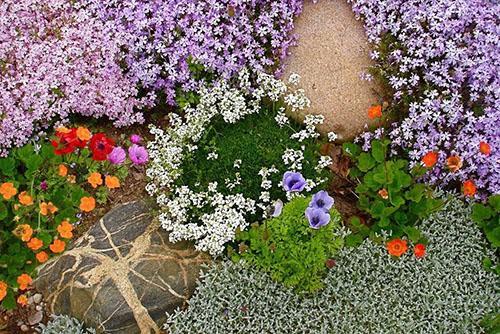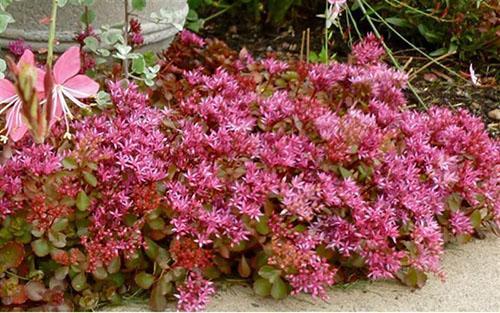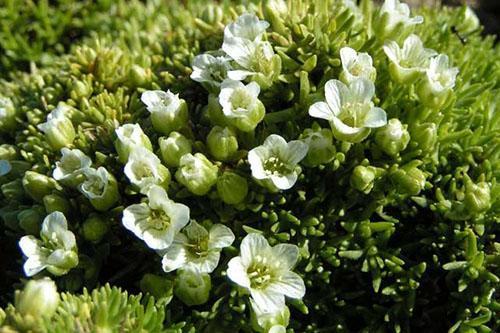Ground cover plants - revival of your summer residence
 For some, a dacha is a place where you can come with your family or friends a couple of times a year for the May holidays or on vacation, and for others it is a second home where a lot of time is spent and a lot of attention is paid to the arrangement. But no matter how it is perceived, any summer resident wants his "home" to look beautiful and well-groomed. Often there is not enough money and time to create a full-fledged design project for a summer cottage and bring it to life, but there are quite budgetary ways to decorate the site yourself so that it looks like a real work of a designer. The use of ground cover plants in landscape design is one such way.
For some, a dacha is a place where you can come with your family or friends a couple of times a year for the May holidays or on vacation, and for others it is a second home where a lot of time is spent and a lot of attention is paid to the arrangement. But no matter how it is perceived, any summer resident wants his "home" to look beautiful and well-groomed. Often there is not enough money and time to create a full-fledged design project for a summer cottage and bring it to life, but there are quite budgetary ways to decorate the site yourself so that it looks like a real work of a designer. The use of ground cover plants in landscape design is one such way.
Types of ground cover plants
Ground cover plants are a group of decorative low-growing plants that have the ability to grow and occupy large areas of the earth. They are divided into many types, each of which is unpretentious.
The most popular and grown in our conditions types of ground cover:
- Sedum - a low plant with small leaves of white (sedum hexagonal), yellow (carpathian sedum), pink (prominent sedum), purple (hare sedum) or red (Kamchatka sedum), collected in an inflorescence.

- Gerbil is a low-growing plant with white rather large flowers.

- Periwinkle is a shrub plant with dense green leaves and large white, purple or lilac flowers. Reach up to 20 cm in height.

- Clefthoof is a plant with large round leaves that forms a kind of shrub. It has no flowers, but it makes it no less beautiful.

- Primula is a representative of ground cover, numbering over 500 varieties. It is a low-growing, growing plant with evergreen leaves and umbellate flowers of purple, yellow, pink, white or red. The fine-toothed primrose with spherical white or bright purple flowers is especially beautiful.

- Iberis is distinguished by its incredible aroma. The most popular variety is the umbrella-shaped Iberis with white or purple umbrella-shaped flowers.

Ground cover plants in landscape design
Due to its decorative and useful properties, ground cover plants can be used in different ways in the country.
Mulching material... They will not become a full-fledged mulch, but they will be able to provide decent protection of the earth from the bright sun, minor precipitation and wind. Plus, live mulch looks much more beautiful than just covering the ground with sawdust or straw.
Different types of sedum and periwinkle are perfect as mulch. But a creeping tenacious loosestrife and it is better to leave thyme for the lawn, as they grow too much and can fill up far not only the area they are intended to protect.
Decoration of paths and paths. Beautifully grown primroses, Iberis or sedum plants, planted along the path on the site, look no less impressive than roses or tulips. Many summer residents prefer their more capricious colors, believing that a plot filled with flowers looks more harmonious than a small area just near the path. Ground covers grow strongly and fill the entire surrounding area, which eliminates the need to come up with a design for the remaining area, as is the case with ground cover roses, tulips and other flowers growing either as bushes or singly.
Blooming lawn... It is a great alternative to a regular lawn with several advantages:
- No need to mow. Groundcover grows only in width, and in height, the growth is always the same;
They even grow in arid and shaded areas where ordinary lawn grass does not survive;
This is a creative and unusual solution for those who do not like monotony.
In order for the lawn to have a presentable appearance, you should think in advance about what it will be.
By planting several varieties of plants together, we get a multi-colored lawn that doesn't look quite like a lawn. Here it is better to give preference to plants of one type or at least one color. If you wish, you can also think over a drawing and plant the seeds in such a way that the plants that will grow from them repeat the invented drawing.
When to plant and how to care for ground cover plants
Ground cover plants are planted and propagated in the spring, when the soil is moist enough and the weather is relatively warm. They grow well in almost any climate and require little maintenance. Moreover, they prevent soil leaching and the appearance of weeds.
Planting ground cover takes place in several stages:
- We prepare the soil: we clear it of weeds and debris, loosen the soil.
- We add complex fertilizer.
- We plant the plants in holes 20-25 m deep. If we want to get a beautiful flowering lawn, we plant them in rows close to each other. In the case of mulch, on the other hand, the planting should not be too dense so that it does not overgrow. When we plant plants by the path, make sure that the planting goes in a row. Here, neglect of accuracy can lead to the fact that the plants "climb" on the path and have to be replanted.

- We fill in the holes and make a small embankment.
- We water the plants.
Caring for ground cover consists of watering them every day for the first 2-3 weeks after planting, watering once a week thereafter, and removing rare weeds.